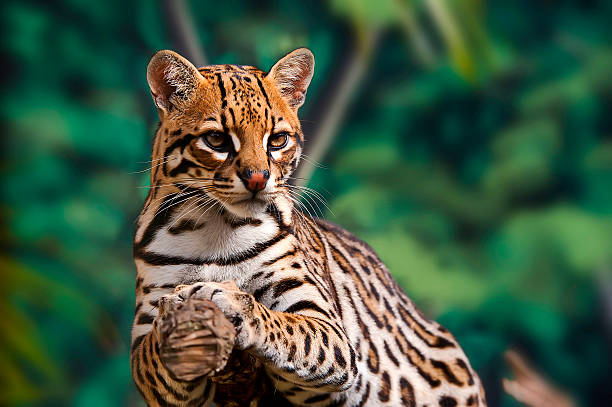Last Updated on January 27, 2024 by Fumipets
Unlocking the World of Ocelot Ownership: What to Know Before Keeping Ocelots as Pets
Embarking on the journey of welcoming an exotic feline companion like an ocelot into your home is an alluring prospect. The idea of sharing your living space with these stunning creatures, known for their striking appearance and elusive nature, can be a dream for many animal enthusiasts. However, before taking the plunge into ocelot ownership, it’s essential to delve into the intricacies and responsibilities that come with caring for these wild cats.
In this guide, we’ll explore the key considerations, challenges, and ethical aspects associated with keeping ocelots as pets. From their natural behavior to legal implications and the commitment required, this comprehensive exploration aims to provide prospective owners with a well-rounded understanding of what it truly means to have an ocelot as a companion.
Keeping Ocelots as Pets
Exotic creatures have a certain allure that people tend to be drawn to. Given the wonderful colors and patterns that certain exotic creatures possess, it’s simple to understand. Exotic animals are a status symbol, but they may also make terrific pets in the right circumstances. To be sure, not every exotic animal makes an excellent home pet. The majority of them will make terrible pets! Exotic animals are notorious for being disruptive, untamed, difficult to handle, loud, untidy, and sometimes hazardous.
Despite this, people continue to seek out amazing animals to keep as pets, and wildcats are towards the top of the list. Though it’s much bigger than your normal housecat, the ocelot isn’t very dangerous when it comes to wildcats. Do ocelots, on the other hand, make nice pets? Let’s go a little more into this unusual feline to determine whether its characteristics point to a superb house cat or a feline that belongs in the wild.
A Bit About Ocelots
Ocelots are medium-sized wildcats with markings like those of a jaguar or puma on their coats. Ocelots live for roughly 7-10 years in the wild, although they may live up to 20 years in captivity. Ocelots are naturally found across South America and most of the Southwest United States.
These cats weigh 28-35 pounds on average, with males weighing somewhat more than females. They are about the same size as some of the biggest domestic house cats, at 16-20 inches in height and 28-35 inches long.
Are Ocelots Endangered?
For many years, the ocelot was considered an endangered species, and tight rules were placed in place to prevent the species from being sold, transported, kept, or hunted. However, worldwide numbers started to thrive, and the ocelot’s conservation status was upgraded to “least concern” on the IUCN Red List. However, since the ocelot’s population is rapidly declining, it’s uncertain what the ocelot’s future holds.

Is Owning an Ocelot Legal?
Selling, shooting, possessing, or shipping an ocelot was very prohibited when they were an endangered species. The ocelot is no longer considered an endangered species, however it is protected in many areas. This implies that keeping an ocelot is far more difficult than keeping a typical domestic pet like a house cat.
Ownership of an ocelot is permitted in certain areas. Other jurisdictions have stringent rules prohibiting them from being kept as pets. In order to do so, you may need to get permissions or pay fees. However, several states, like Alaska and New England, have explicitly prohibited them as pets. If you determine that having an ocelot is correct for you, be sure to do your homework on whether or not keeping an ocelot as a pet is legal where you reside.
11 Issues with Keeping Ocelots as Pets
Keeping exotic creatures as pets, such as ocelots, has a number of risks. Be prepared to cope with the following 11 ocelot disadvantages, which range from harsh scents to behavioral issues.
1. Ocelots Hunt All the Time
Ocelots spend the most of their time hunting in the wild. Your ocelot will also want to spend its time hunting, putting the pets of your neighbors in jeopardy! You can reduce this with toys and a variety of entertaining activities that resemble hunting or killing, but you’ll never be able to completely eliminate your ocelot’s need to hunt.
2. Wildcats Have Strong Odors
Ocelots, like other wildcats, have significantly stronger scents in their feces than your normal housecat. Because these cats are notorious for producing powerful odors, expect the litter box to be a source of considerable stench.
3. Scent Marking Is an Issue
We recently spoke about how powerful the scents from an ocelot’s waste are, but keep in mind that your ocelot will want to leave its fragrance all over its territory, even where it sleeps. You can teach your ocelot to avoid this behavior, but it’s a strong natural tendency, so you’ll need to begin teaching early in your ocelot’s life and be persistent with it.
4. Behavioral Problems Are Common
Young ocelots remain with their moms for far longer in the wild than other cat species. Early separation of a newborn from its mother may lead to a variety of behavioral issues.
5. Ocelots Are Extremely Dependent and Needy
Ocelots need a great deal of care and contact. You’ll need to devote many hours each day to caring for your pet ocelot. If you don’t, it will begin to scream, and ocelots are very loud. This tendency is exacerbated in ocelots who have been removed from their mothers, as most ocelots kept as pets have been.
6. You’ll Need Lots of Space
An ocelot, unlike domestic house cats, can never be healthy or happy trapped within your home. For your ocelot to go around and exercise, you’ll need lots of outside area. Your ocelot will need at least 900 square yards of outdoor area, which must be safe and impenetrable, lest your neighbors’ pets become prey for your ocelot.
7. They’re Very Destructive
Because of their destructive natures, wildcats make lousy pets. They dismantle stuff and scrape up walls. Even if accidentally, their claws will ruin carpet and furniture. Ocelots will try to scent mark all over your house, and they will gnaw on whatever they can get their hands on. Because these cats like climbing, make sure you take down any delicate items or risk having them knocked to the ground by your naughty ocelot.
8. Exotic Animals Require Specialized Vets
Medical treatment is something that should not be overlooked. Ocelots, like other exotic pets, need specialized care that is outside the scope of a typical veterinarian’s expertise. As a result, you’ll need to find a trained exotic animal veterinarian to care for your ocelot. Naturally, these veterinarians are more expensive than your regular vet, and you’ll have to travel a long distance to get to their offices.
9. They’re Difficult to Acquire
When was the last time you saw an ocelot being sold at a pet store? The answer is almost surely never, and you will almost certainly never. If you want to buy an ocelot, you’ll need to locate an exotic pet trader.
10. Ocelots Cost a Lot
Even if you manage to meet an exotic pet trader, you’ll need to come up with substantial money to buy an ocelot, which may cost up to $20,000. You can acquire them for less money, but the lower the price, the more likely you are to receive a problem animal. Despite this, normal ocelot costs vary from $1,500 to $15,000, depending on the ocelot’s health, age, and size, among other things.
11. They’re Difficult to Feed
Ocelots devour other animals in the wild. They hunt down these creatures, kill them, and eat them. Your ocelot will still have a strong urge to follow in your footsteps. Instead, you’ll have to offer the same nourishment that our ocelot would have, which might be challenging. You’ll probably need to supplement with taurine and provide enough organ meat to your ocelot.

Why Keep an Ocelot as a Pet?
Despite the many issues that might arise with owning an ocelot, there are certain benefits that ocelot owners can enjoy. Even though they are exceedingly dependent, many ocelots grow out to be quite devoted and caring companions.
If you like ocelots, having one that needs you every day and wants to snuggle up on your lap and lick your finger would be the best reward you could wish for. However, not everyone is capable of meeting the extensive responsibilities of maintaining an ocelot as a pet, so be sure you’re actually prepared for such a commitment and not simply swept up in the thrill of having such an unusual pet.
Conclusion
The fact is that pet ownership is very personal. What one person deems a wonderful pet may be a terrible match for another. Some people, for example, might not want to care for a giant lizard that would never snuggle up on the sofa with them, while others grow infatuated with their reptiles and can’t get enough of them.
All of this is to suggest that owning an ocelot is a challenging journey that needs significant time, effort, and financial commitment. It’s not for everyone, but if you’re the proper kind of person, it may be quite gratifying. Just be sure you know what you’re getting yourself into before you pull the trigger. You’re in it for the long run once you bring an ocelot home, which may be two decades or more.
Questions and Answers About Keeping Ocelots as Pets
Are Ocelots Legal Pets?
While laws regarding the ownership of ocelots vary globally and locally, it’s crucial to research and adhere to the regulations in your specific region. Many places require permits and licenses to own exotic animals, including ocelots. Before considering an ocelot as a pet, ensure you are compliant with all legal requirements.
What Kind of Environment Do Ocelots Need?
Ocelots, being wild cats, have specific environmental needs that can be challenging to replicate in a home setting. They require ample space, climbing structures, hiding spots, and opportunities for mental and physical stimulation. Creating a habitat that mimics their natural environment is crucial for their well-being.
What is the Dietary Requirement for Ocelots?
Ocelots are carnivores with a diet primarily consisting of meat. Replicating their natural prey in captivity is essential. This might include a diet of raw meat, bones, and, in some cases, specially formulated commercial diets. Consulting with a veterinarian experienced in exotic animal care is vital to ensure a balanced and nutritionally adequate diet.
How Do Ocelots Behave in Captivity?
Ocelots retain many of their wild instincts, and their behavior can be unpredictable. While some may adapt to human companionship, others may remain aloof or display territorial aggression. It’s crucial to understand their natural behaviors and provide an environment that accommodates their instincts, minimizing stress for both the ocelot and its owner.
What is the Long-Term Commitment of Owning an Ocelot?
Ocelots can live up to 20 years or more in captivity, making ownership a long-term commitment. Considerations should include financial responsibilities, veterinary care, and the time required for daily interaction and enrichment. Potential owners must be prepared for the challenges and responsibilities that come with caring for an ocelot throughout its entire lifespan.


















